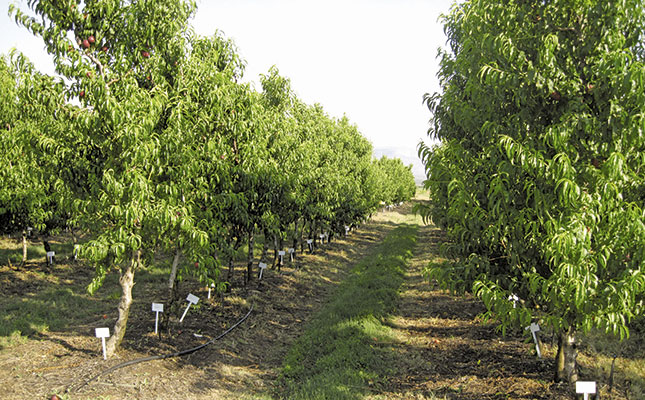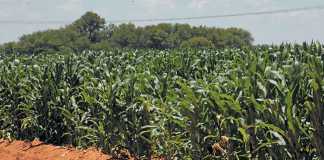
Kakamas and Marianne have been used as rootstocks for stone fruit production since the 1950s. They still produce good yield, but better rootstocks are now available. Under the right conditions, the new rootstocks can reduce costs and improve fruit yield and quality, private consultant Dr Piet Stassen told delegates at a farmer information day hosted by the Canning Fruit Producers’ Association near Robertson.
Stassen has been evaluating various new stone fruit rootstocks under different production conditions over five harvest seasons in trials at Worcester, Stellenbosch, Robertson and Bonnievale in the Western Cape as well as at Mookgophong in Limpopo.
In these trials, trees grafted on Atlas, Viking, Garmen, Cadaman and GF 677 performed well in alkaline soil with a pH (KCl) of between 7 and 8. Trees grafted on Guardian, Kakamas seedlings, Flordaguard, SAPO 778 and Sandvliet performed poorly in such alkaline soils.

Dr Piet Stassen
There was no difference in yield and fruit size in rootstocks that performed well in alkaline soil. But Garmen flowered up to eight days earlier than the other rootstocks. Stassen found that Flordaguard and Kakamas were highly sensitive to iron deficiency in alkaline soils with a pH (KCl) of above 8, followed by Tsukuba and Guardian. Viking and Atlas also produced symptoms of iron chlorosis, but the impact on fruit yield was lower than with Flordaguard and Kakamas.
Flordaguard, followed by Cadaman and Atlas, performed the best of all rootstocks in soil with a sand content of 90% and higher. Kakamas, Viking and SAPO 778 did less well and tended to dry out and show stress symptoms when under-irrigated. Kakamas, SAPO 778, Atlas, Viking, Garnem and Cadaman performed best in high-potential soil with a silt and clay content of 20% and higher.
Stassen warned that farmers had to keep an eye on Cadaman and Garnem, as these grew vigorously in high potential soil.
“They would require additional summer pruning to keep them under control,” he explained.
Ring and lesion nematodes
According to Stassen, rootknot nematodes, which cause galls on tree roots, are less of a problem with the new rootstocks. By contrast, ring nematodes, which destroy feeder roots, and lesion nematodes, which feed on the outside and inside of roots, remain a concern, and farmers have to “work smartly” to stay on top of them.
Stassen found that GF 677 and Kakamas were highly sensitive to rootknot nematodes. Guardian, Atlas, Viking proved to be tolerant, while Marianna, Maridon, Flordaguard and Garnem exhibited total resistance. On the other hand, Marianna and Tsukuba 4 and 5 were also highly sensitive to ring nematodes. “With Marianna, you have to treat the soil for nematodes before you plant,” Stassen said. “Garnem is sensitive, while Atlas is a host for ring nematodes, but this didn’t seem to have a negative impact on production.”
He is still evaluating the performance of rootstocks planted in soil with a high population of lesion nematodes. Results so far suggest that GF 677, Flordaguard, Cadaman and Garmen are highly sensitive to these nematodes, which have a negative impact on fruit size.
Climate
Stassen admitted that he would not plant SAPO 778 or early cultivars in areas that experience fewer than 300 cold units per year. In warm areas, this rootstock could delay leaf emergence and also lead to stress, which, when combined with other factors, could lead to fungi and stem canker problems. However, SAPO 778 has many advantages, such as larger fruit, as long as the area has more than 500 cold units.
In the study, Flordaguard did not become completely dormant, and sprouted early in an area with fewer than 300 cold units. Stassen recommended it for early cultivars in warm areas, as well as areas with an early warm spring. He admitted that alternative ways had to be found to improve propagation of clonal rootstocks, as the take percentage of the new rootstocks was not as high that of the rootstocks the industry had used up to now.
“Failure to do so will affect nurseries and result in producers being supplied with trees with poorly developed root systems lacking feeder roots,” he explained. “This will have a negative impact on the establishment of orchards. Trees die because of waterlogging, a shortage of water and because their roots are unable to support their development.”
Selecting the correct rootstock for a specific area was not an easy task, he added. With many factors to be considered, he recommended that a farmer use a consultant to guide his decisions. He should also order trees several years in advance to ensure that they were available at planting time.
Phone Dr Piet Stassen at 082 928 2470 or email [email protected].













